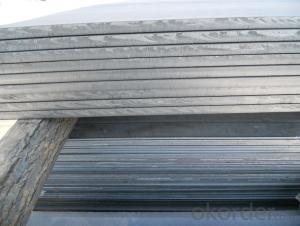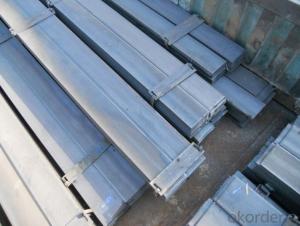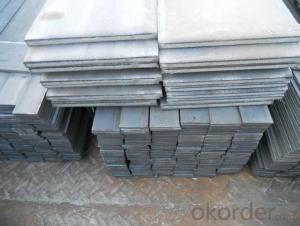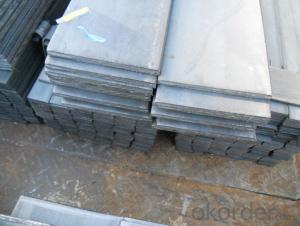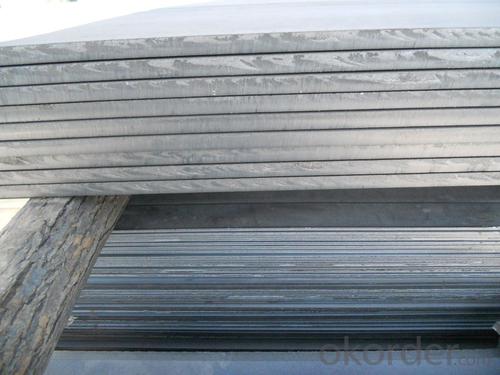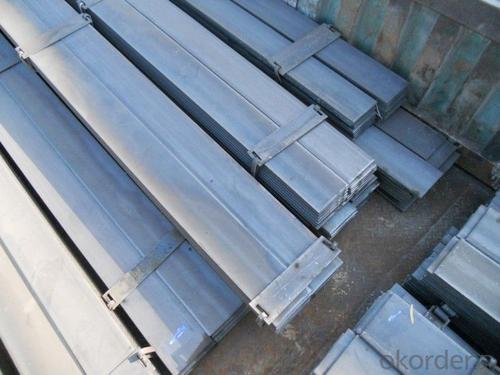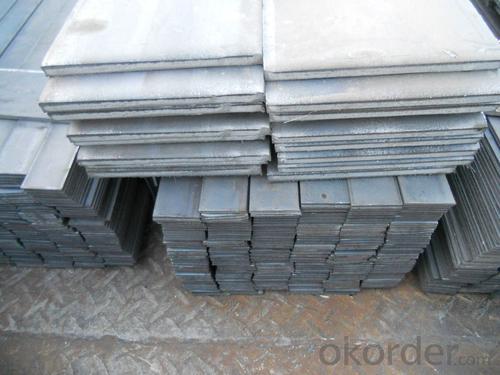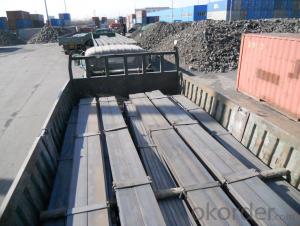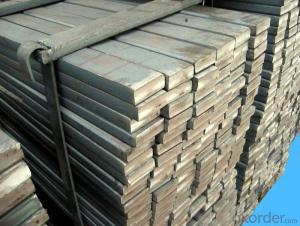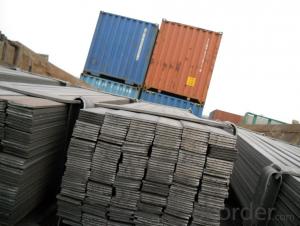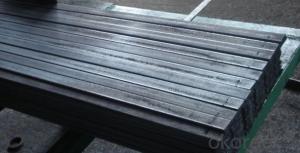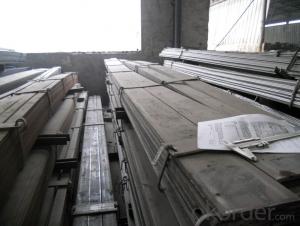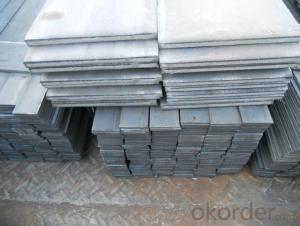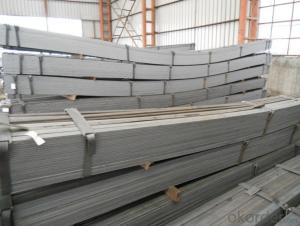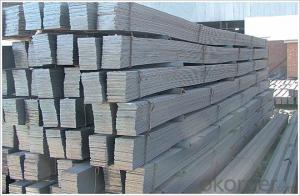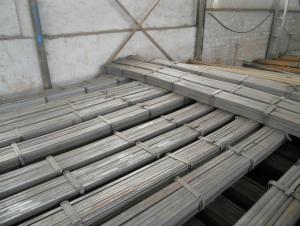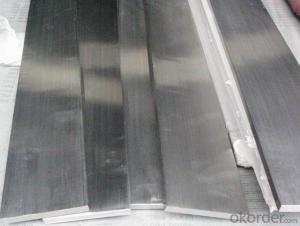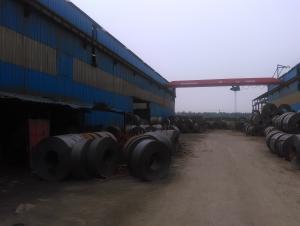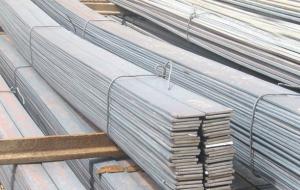Hot Rolled Seel Flat Bars with Material Grade Q235/SS400
- Loading Port:
- Tianjin
- Payment Terms:
- TT OR LC
- Min Order Qty:
- 25 m.t.
- Supply Capability:
- 10000 m.t./month
OKorder Service Pledge
OKorder Financial Service
You Might Also Like
Product Description:
OKorder is offering high quality Flat Bar at great prices with worldwide shipping. Our supplier is a world-class manufacturer of steel, with our products utilized the world over. OKorder annually supplies products to European, North American and Asian markets. We provide quotations within 24 hours of receiving an inquiry and guarantee competitive prices.
Product Applications:
Flat Bars are ideal for structural applications and are widely used in the construction of buildings and bridges, and the manufacturing, petrochemical, and transportation industries.
Product Advantages:
OKorder's Flats Barare durable, strong, and resist corrosion.
Main Product Features:
· Premium quality
· Prompt delivery & seaworthy packing (30 days after receiving deposit)
· Corrosion resistance
· Can be recycled and reused
· Mill test certification
· Professional Service
· Competitive pricing
Product Specifications:
Manufacture: Hot Rolled
Grade: Q195 – 235 ;SS400
Certificates: ISO, SGS, BV, CIQ
Length: 6m – 12m, as per customer request
Packaging: Export packing, nude packing, bundled
Chemical composition of Q235
Alloy No | Grade | Element(%) | ||||
C
| Mn
| S
| P
| Si
| ||
Q235
|
B
|
0.12—0.20 |
0.3—0.7 |
≤0.045 |
≤0.045
|
≤0.3
|
Physical properties of Q235
Alloy No | Grade | Yielding strength point(Mpa) | Tensile strength (Mpa) | Elongation after fracture(%) | ||||||
Thickness (mm) | Thickness (mm) | |||||||||
≤16 | >16--40 | >40--60 | >60--100 | ≤16 | >16--40 | >40--60 | >60--100 | |||
≥ | ≥ | |||||||||
Q235 |
B |
235 |
225 |
215 |
205 |
375--500 |
26 |
25 |
24 |
23 |
FAQ:
Q1: How soon can we receive the product after purchase?
A1: Within three days of placing an order, we will begin production. The specific shipping date is dependent upon international and government factors, but is typically 7 to 10 workdays.
Q2: How do we guarantee the quality of our products?
A2: We have established an advanced quality management system which conducts strict quality tests at every step, from raw materials to the final product.
Q3: The products are invoicing on theoritical weight or on actual weight basis ?
A3: We can do it in both manners, according to buyers' requirement.
Q4: What is the normal tolerance of your falt bars ?
A4: Normally 7%-9%, but we can also produce the goods according to the customers' requests.
Images:
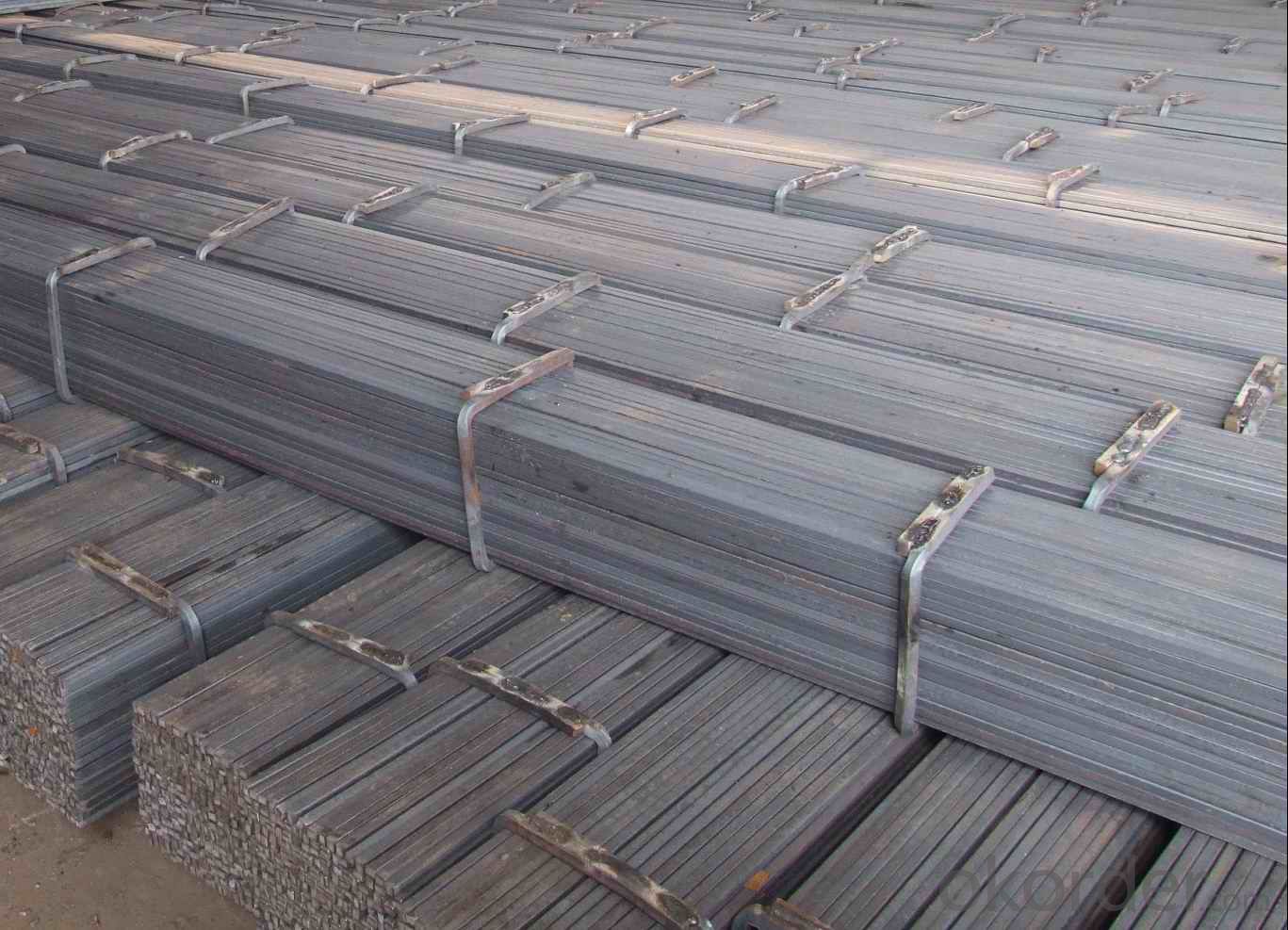
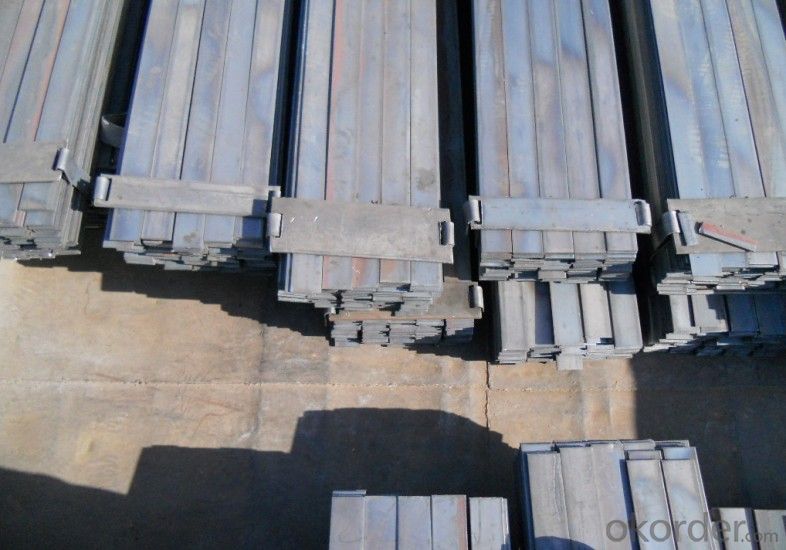
- Q: What are the common methods of surface protection for steel flat bars?
- There are several common methods of surface protection for steel flat bars. These methods are employed to prevent corrosion and extend the lifespan of the steel flat bars. One common method is the application of a protective coating. This can be done through processes such as galvanizing, where a layer of zinc is applied to the surface of the steel flat bar. This zinc coating acts as a sacrificial layer, protecting the steel from corrosion. Another coating option is painting, where a layer of paint is applied to the surface. The paint acts as a barrier, preventing moisture and other corrosive elements from reaching the steel. Another method of surface protection is the use of corrosion inhibitors. These inhibitors are often applied as a thin film or coating on the surface of the steel flat bar. They work by forming a protective layer that inhibits the corrosion process. Corrosion inhibitors can be applied by spraying, brushing, or dipping the steel flat bars into a solution containing the inhibitor. Additionally, some steel flat bars are protected through the process of metal plating. This involves applying a thin layer of a different metal, such as chrome or nickel, onto the surface of the steel. The plating serves as a protective barrier, preventing corrosion and enhancing the aesthetics of the steel flat bar. Lastly, another method of surface protection for steel flat bars is mechanical surface treatments. These treatments include processes such as shot blasting or sandblasting, where small abrasive particles are propelled at high speeds to remove any rust or surface contaminants. This helps to create a clean and smooth surface, ready for further protection, such as painting or coating. Overall, the common methods of surface protection for steel flat bars include protective coatings, corrosion inhibitors, metal plating, and mechanical surface treatments. The choice of method depends on factors such as the intended use of the steel flat bars, environmental conditions, and aesthetic requirements.
- Q: Are steel flat bars suitable for outdoor signage or display structures?
- Steel flat bars are a great choice for outdoor signage or display structures. With its durability and strength, steel can endure different weather conditions, making it perfect for outdoor use. These flat bars provide stability and support, making them suitable for creating sturdy signage or display structures that can withstand wind, rain, and other environmental elements. Moreover, steel can be easily fabricated and customized to meet specific design needs, offering versatility and visually pleasing outdoor displays.
- Q: How do steel flat bars perform under impact or shock-loading conditions?
- Steel flat bars exhibit excellent performance when subjected to impact or shock-loading due to their exceptional strength and durability. The inherent characteristics of steel, including its high tensile strength and resilience, render it an optimal material for withstanding abrupt and forceful impacts. When faced with impact or shock-loading, steel flat bars possess the capability to absorb and distribute the energy uniformly throughout their structure. This capacity helps to avert localized failure and guarantees the even dispersion of the force. Consequently, steel flat bars are less prone to deformation, fracture, or breakage under these circumstances. Moreover, steel showcases remarkable resistance to fatigue, thereby enabling it to endure repetitive impacts without experiencing significant deterioration in its performance. This quality makes steel flat bars highly suitable for applications where dynamic loads or sudden impacts are prevalent, such as in the realms of construction, automotive manufacturing, or industrial machinery. Nevertheless, it is essential to acknowledge that the specific performance of steel flat bars under impact or shock-loading conditions may vary depending on several factors, including the quality of the steel utilized, the dimensions of the flat bar, and the particular application involved. Hence, it is crucial to carefully consider the specific requirements and seek guidance from experts or engineers to ensure the appropriate steel grade and design are employed for the intended purpose.
- Q: What is the maximum temperature that steel flat bars can withstand?
- The maximum temperature endurance of steel flat bars relies on several factors, including the type of steel, its composition, and the intended usage. In general, most steel flat bars can endure temperatures ranging from 600-900 degrees Celsius (1100-1650 degrees Fahrenheit) without experiencing significant deformation or loss of structural integrity. Nevertheless, it is essential to refer to the manufacturer's specifications or engineering standards for precise information on the maximum temperature tolerance of a specific steel flat bar. Moreover, the duration of exposure to high temperatures can impact the maximum temperature endurance of steel flat bars. Sustained exposure to extreme temperatures can diminish strength and potentially lead to failure. Consequently, it is vital to consider the intended usage and adhere to industry guidelines to ensure the safe and effective utilization of steel flat bars under elevated temperatures.
- Q: Where is the use of flat steel in electrical use?
- The flat steel used in the project consists of two types: galvanized and non galvanized. Galvanized is mainly used in decorative materials and pipes, such as rings, hoop and so on;
- Q: How do you prevent twisting of steel flat bars during welding?
- To prevent twisting of steel flat bars during welding, there are several measures you can take: 1. Proper preparation: Ensure that the flat bars are clean and free of any contaminants, such as oil, grease, or rust. Use a wire brush or grinder to remove any surface impurities. 2. Proper clamping: Securely clamp the flat bars in place before welding. Use sturdy clamps or magnetic welding fixtures to hold the bars firmly in position, preventing any movement or twisting during the welding process. 3. Tack welding: Prior to performing the full weld, use tack welds to temporarily hold the flat bars together. This will help maintain their alignment and prevent twisting while the final weld is being applied. 4. Weld sequence: Adopt a strategic weld sequence that minimizes heat distortion and potential twisting. Avoid welding a continuous bead along the entire length of the flat bars, as this can generate excessive heat and cause distortion. Instead, alternate between different sections or weld in short intervals, allowing each area to cool before proceeding. 5. Minimize heat input: Control the heat input during welding by using the appropriate welding technique and adjusting the welding parameters. High heat levels can cause the steel to expand and contract, leading to twisting. Employing techniques such as pulse welding or reducing the amperage can help control heat input and minimize the risk of twisting. 6. Preheating and post-weld heat treatment: For thicker or more susceptible steel flat bars, preheating the material before welding can help reduce the risk of twisting. Additionally, performing post-weld heat treatment can relieve residual stresses and prevent distortion. 7. Slow cooling: Allow the welded flat bars to cool slowly and naturally after welding. Rapid cooling, such as through water quenching, can induce additional stresses and contribute to twisting. Avoid abrupt temperature changes and provide adequate time for the welded bars to cool down gradually. By implementing these preventive measures, you can significantly reduce the risk of twisting in steel flat bars during welding, ensuring a successful and distortion-free weld.
- Q: Can steel flat bars be used in the construction of pipelines?
- Steel flat bars are indeed applicable in pipeline construction. They are extensively utilized in diverse industries, such as construction, owing to their robustness, endurance, and adaptability. In the context of pipeline construction, steel flat bars are frequently employed as supports, brackets, or reinforcements within the pipeline framework. Moreover, they can serve as a foundation for pipe hangers, offering extra vigor and stability to the entire pipeline system. Furthermore, by welding or bolting steel flat bars together, bespoke fittings or connections can be created for the pipeline. In conclusion, steel flat bars represent a dependable and economical option for implementing in pipeline construction.
- Q: How do steel flat bars contribute to the overall sustainability of residential projects?
- There are several ways in which steel flat bars contribute to the overall sustainability of residential projects. To begin with, steel is an incredibly durable and long-lasting material. Steel flat bars have the ability to resist corrosion, weathering, and pests, meaning that they require minimal maintenance throughout their lifespan. This durability ensures that residential structures built with steel flat bars have a longer lifespan, reducing the need for frequent repairs and replacements. As a result, this reduces waste and conserves resources. In addition, steel is one of the most recycled materials globally. At the end of their life, steel flat bars can be easily recycled, thus reducing the demand for new steel production and the associated environmental impacts. This recycling process requires less energy and emits fewer greenhouse gases compared to the production of new steel. By incorporating steel flat bars into residential projects, we are actively promoting the reuse and recycling of materials, thus contributing to the circular economy. Moreover, steel flat bars offer strength and versatility in construction. Their high strength-to-weight ratio allows for lighter structural elements, which reduces the overall weight of the building and the amount of material needed. This not only minimizes the environmental impact during the construction phase but also reduces the load on the foundation, potentially leading to energy savings over the lifespan of the building. Steel flat bars also provide design flexibility, further contributing to the sustainability of residential projects. They are available in various sizes, shapes, and finishes, allowing architects and engineers to create innovative and efficient designs. This flexibility enables the optimization of material usage, minimizing waste and maximizing resource efficiency. Lastly, steel flat bars are fire-resistant, making them a safe choice for residential construction. This fire resistance enhances the overall safety of the building and reduces the risk of fire-related damage or loss. Ultimately, this helps minimize the environmental impact associated with rebuilding or repair. Overall, incorporating steel flat bars into residential projects promotes sustainability by providing durability, recyclability, strength, design flexibility, and fire resistance. These sustainable features help reduce waste, conserve resources, and minimize the environmental footprint of the built environment.
- Q: What is the thickness tolerance for steel flat bars?
- The thickness tolerance for steel flat bars can vary depending on the specific grade and manufacturing standard being followed. However, in general, the industry standard tolerance for steel flat bars is typically +/- 0.005 inches (0.127mm) to +/- 0.010 inches (0.254mm). This means that the actual thickness of a steel flat bar can deviate within this range from the specified nominal thickness. It is important to consult the relevant manufacturing standard or supplier specifications for the specific tolerance requirements of the steel flat bars being considered.
- Q: What are the different types of steel flat bar profiles?
- There are several different types of steel flat bar profiles available, each designed for specific applications and requirements. Some common types include: 1. Mild Steel Flat Bar: This is the most commonly used type of steel flat bar, known for its versatility and affordability. It is often used in construction, manufacturing, and general fabrication projects. 2. Stainless Steel Flat Bar: Stainless steel flat bars are corrosion-resistant and have high strength. They are commonly used in industries such as food processing, chemical, and marine applications where resistance to rust and corrosion is crucial. 3. Alloy Steel Flat Bar: Alloy steel flat bars are made by adding various elements such as chromium, nickel, or molybdenum to enhance their strength, hardness, and durability. They are commonly used in applications where high strength and resistance to wear and tear are required. 4. Tool Steel Flat Bar: Tool steel flat bars are specifically designed for use in cutting tools, mold-making, and other tooling applications. They possess high hardness, wear resistance, and toughness, making them suitable for machining and shaping operations. 5. Carbon Steel Flat Bar: Carbon steel flat bars contain primarily carbon as the main alloying element. They are known for their high tensile strength, excellent weldability, and affordability. Carbon steel flat bars find applications in structural components, machinery parts, and general fabrication. Each of these flat bar profiles has its own unique properties and application-specific advantages. The choice of the right type depends on factors such as the intended use, environmental conditions, and required mechanical properties.
Send your message to us
Hot Rolled Seel Flat Bars with Material Grade Q235/SS400
- Loading Port:
- Tianjin
- Payment Terms:
- TT OR LC
- Min Order Qty:
- 25 m.t.
- Supply Capability:
- 10000 m.t./month
OKorder Service Pledge
OKorder Financial Service
Similar products
Hot products
Hot Searches
Related keywords
